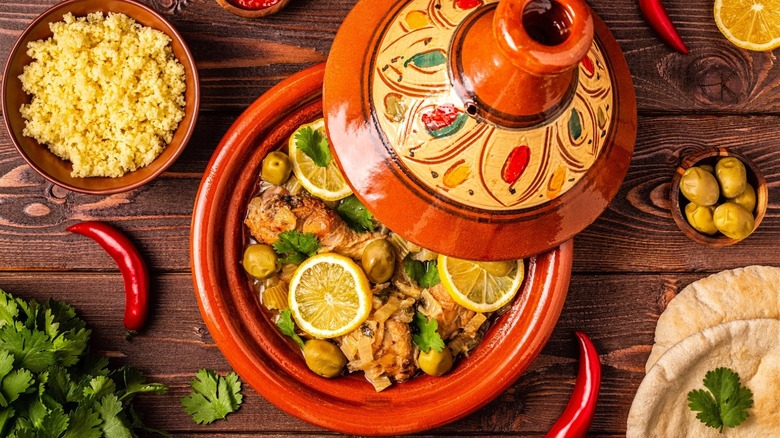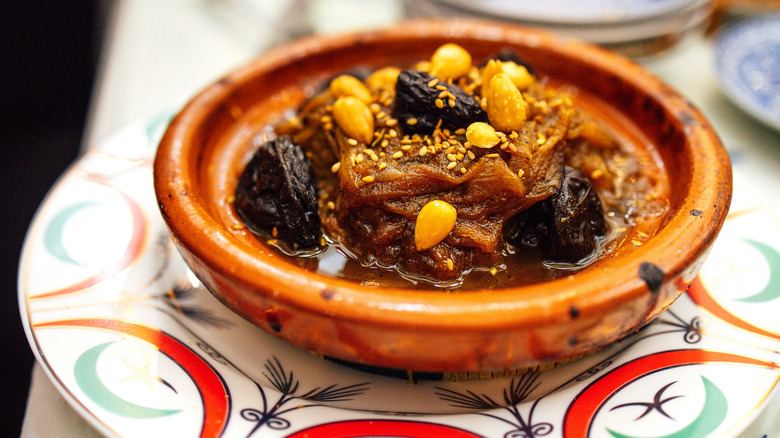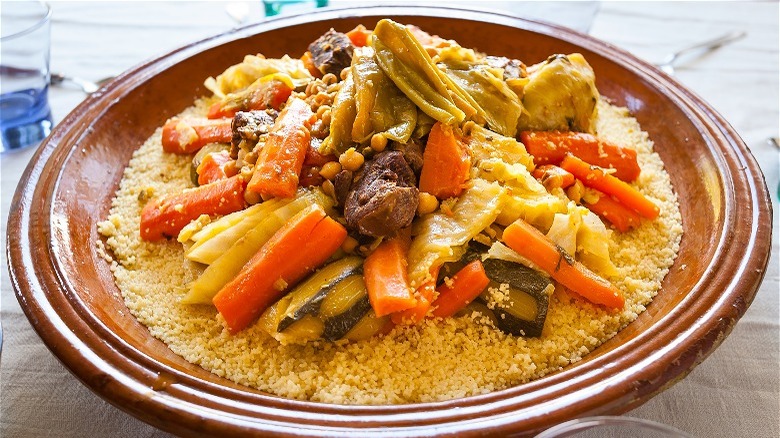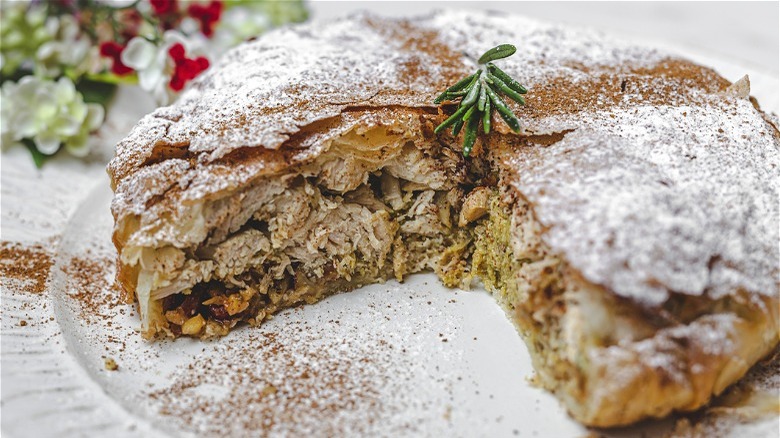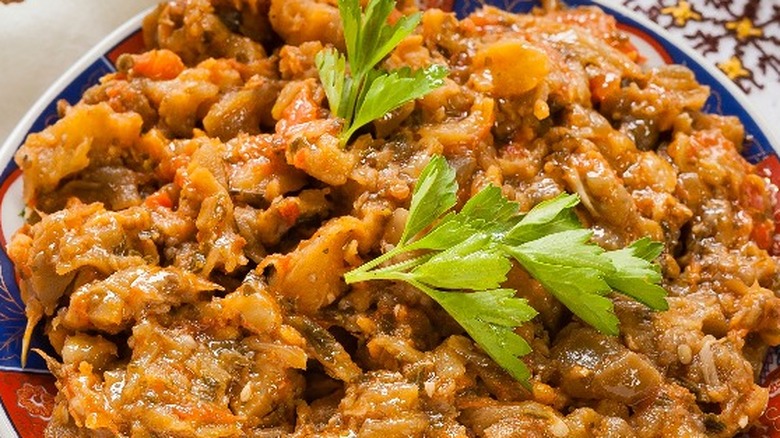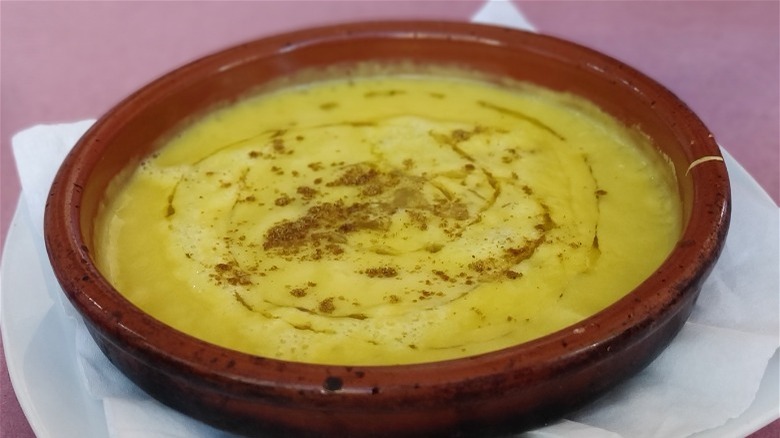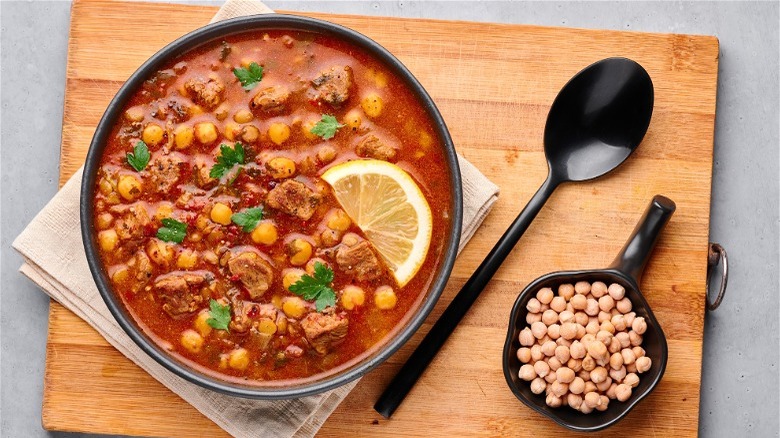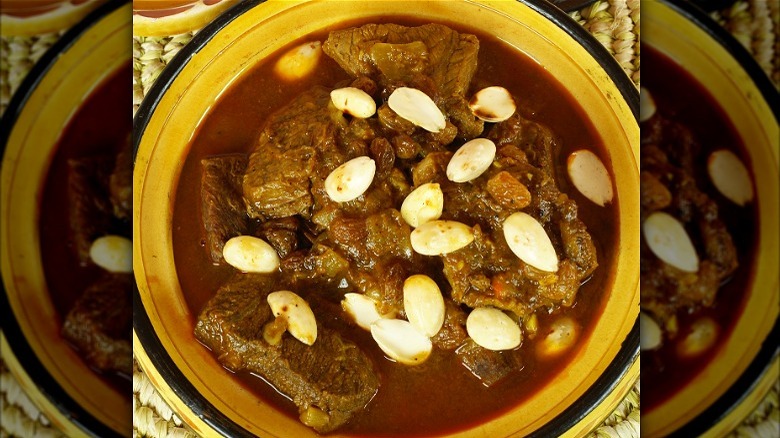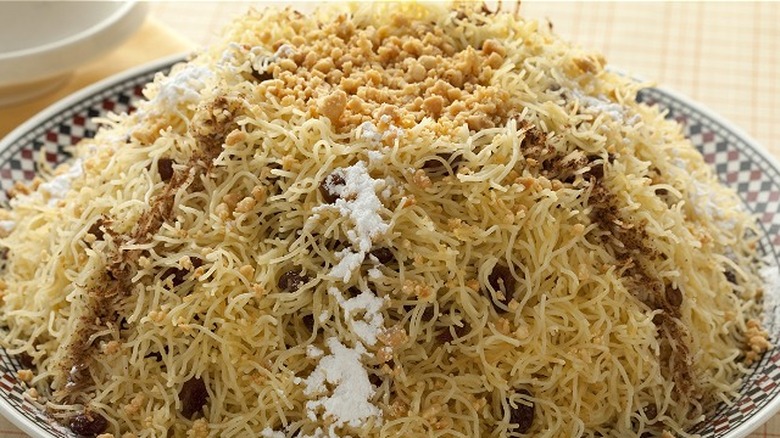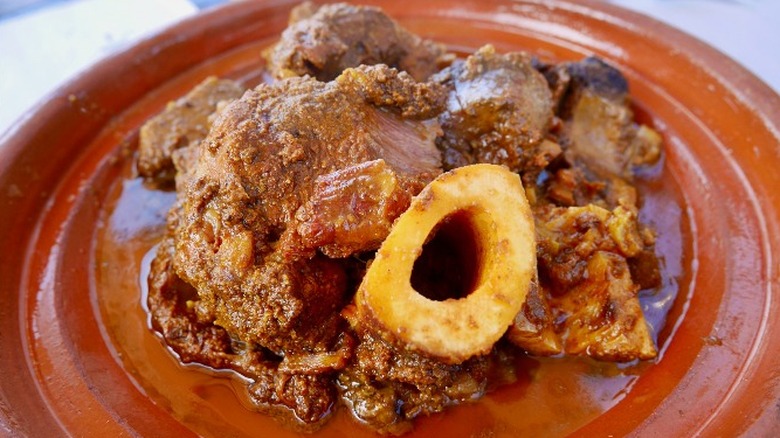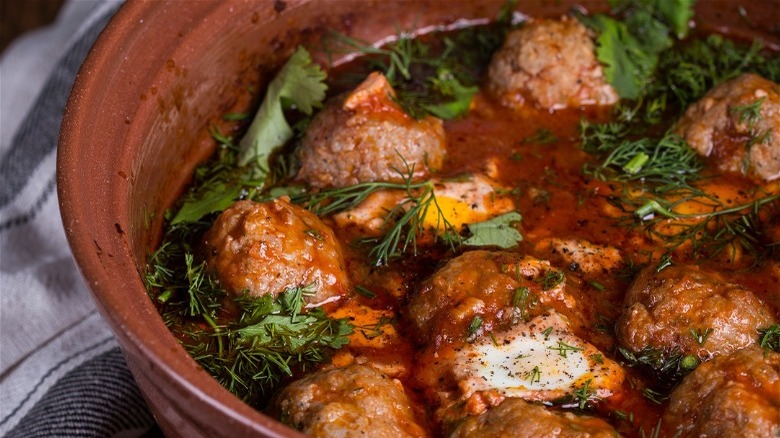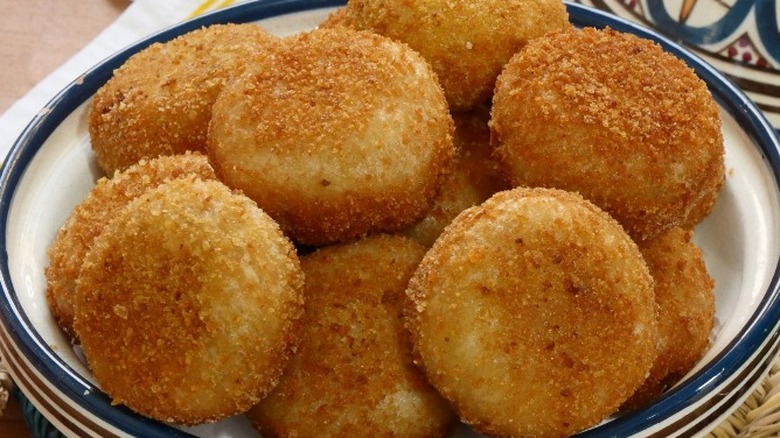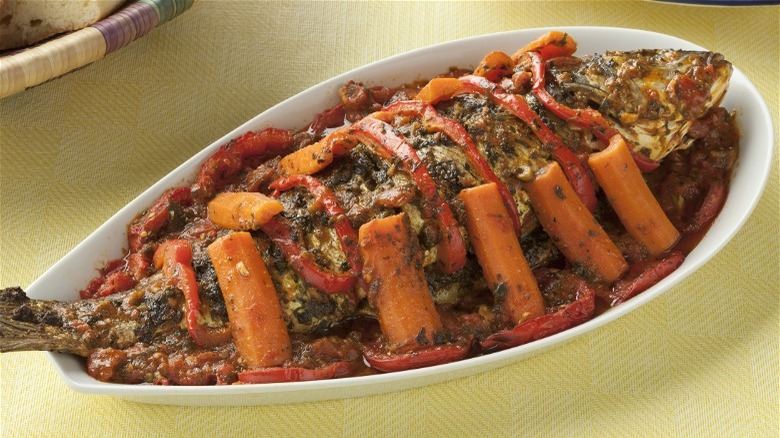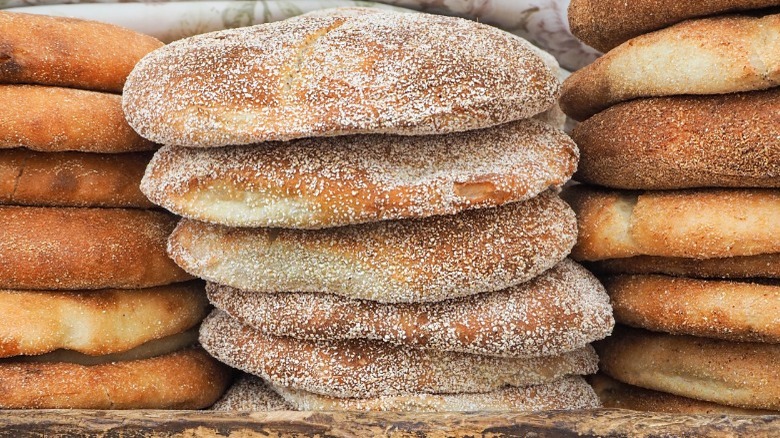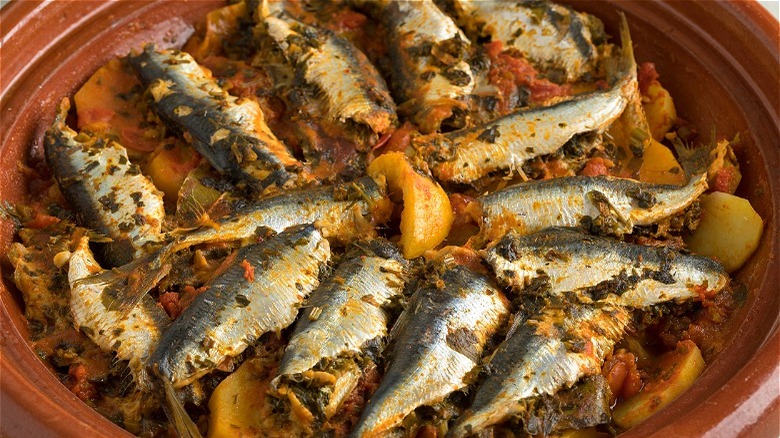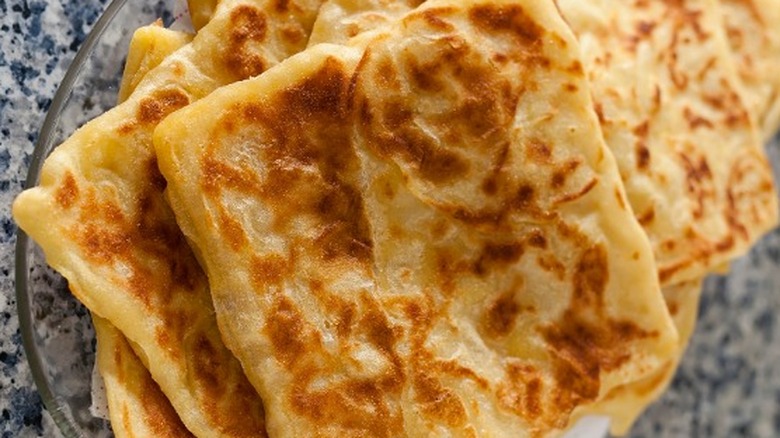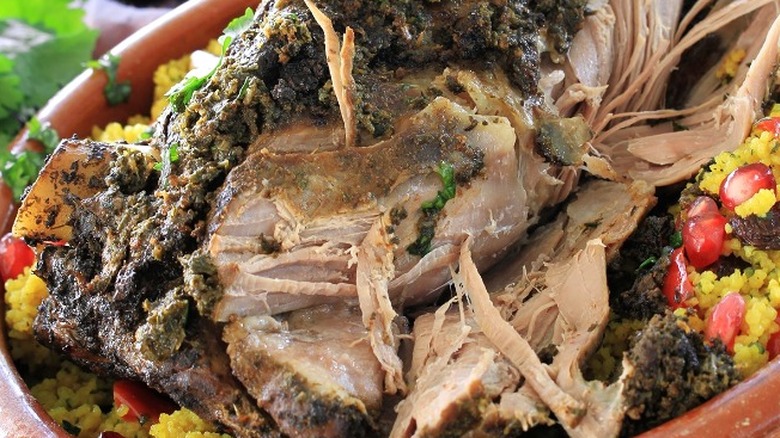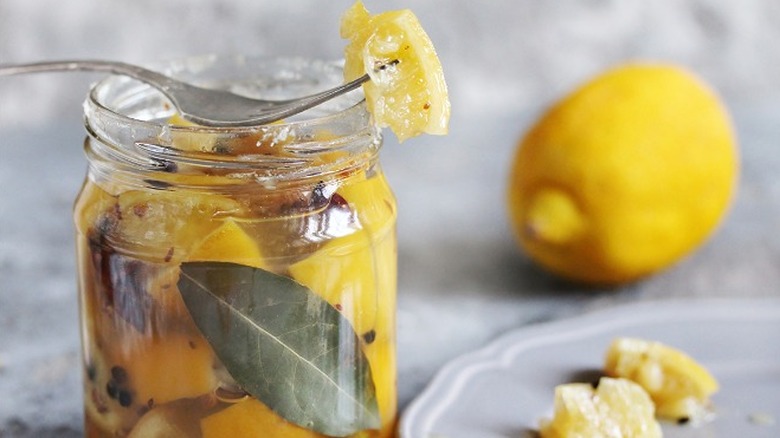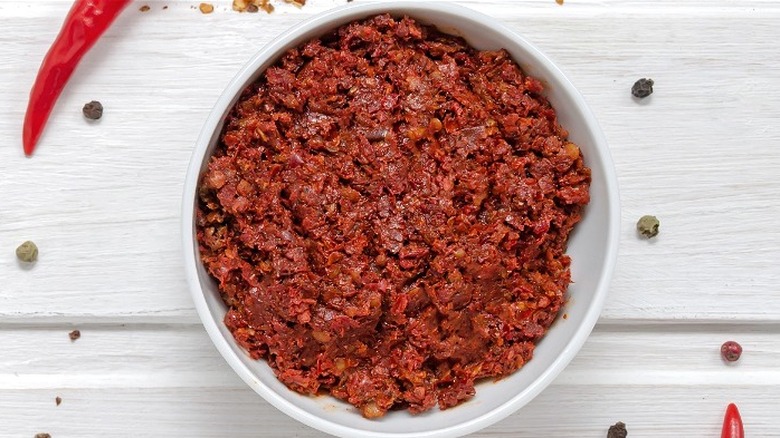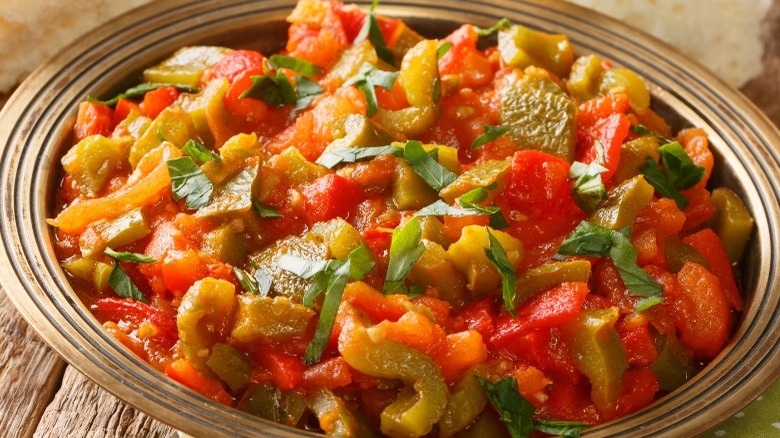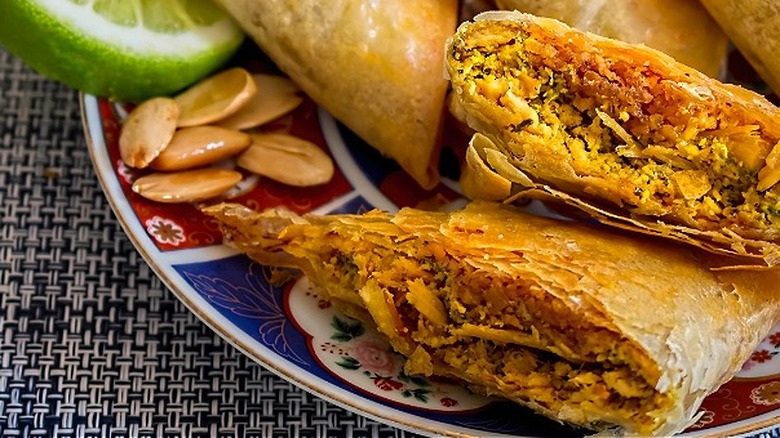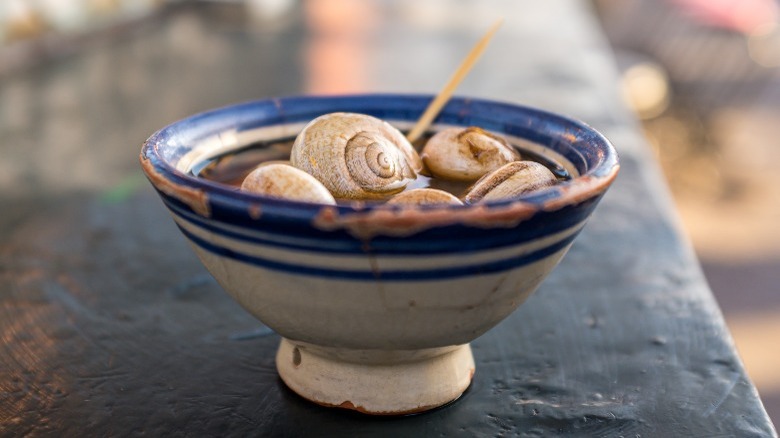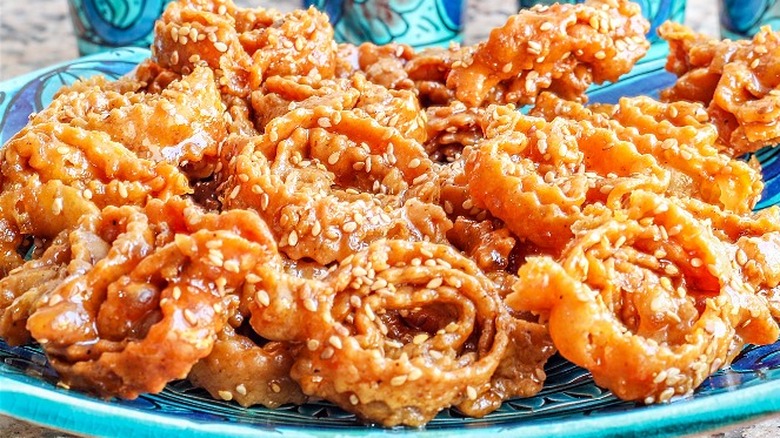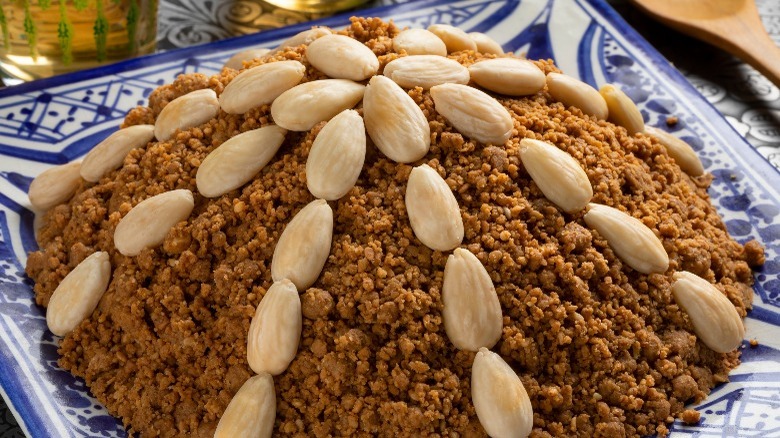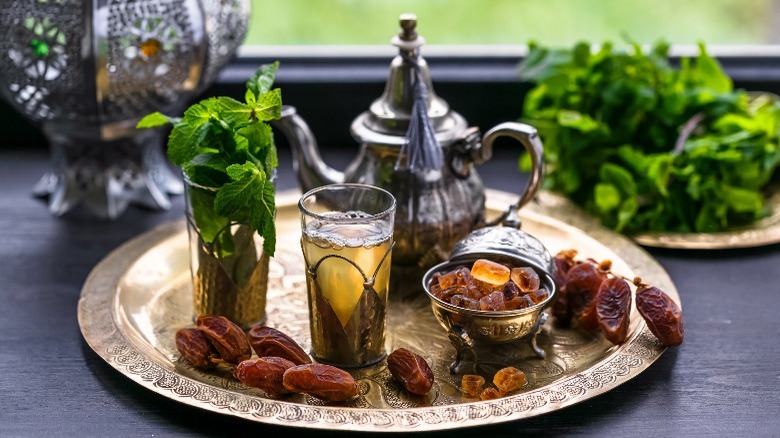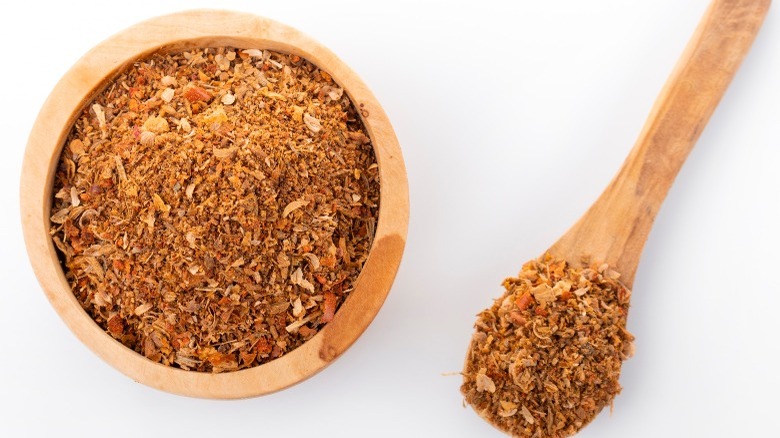25 Must-Try Moroccan Foods
Moroccan food is for lovers of spice and flavor. Many of the dishes typically eaten in Morocco on any given day represent more than just the cuisine of a culture. They're often eaten in a shared setting with each person taking food from the section in front of them, creating a communal vibe. As if that wasn't interesting enough, the dishes often leverage spices like cinnamon, ginger, turmeric, and paprika to create warming notes. Meat is prepared to the point that it may just melt in your mouth meats, which is only improved by pairing it with warm, freshly-baked bread. It's easy to see why Moroccan food is a favorite among foodies!
We've rounded up 25 essential must-try Moroccan foods to try, some of which are even simple enough to prepare at home. They will give you a starting point for exploring this culture through its exciting dishes. Keep reading to see our pick for 25 must-try Moroccan dishes.
Tagine
Tagine is beloved as both a type of cookware and a type of dish. The Tagine is more or less a portable oven — a means to have a hot meal with stewed meats and/or vegetables anytime, any place. The clay pot consists of 2 parts — the base is a shallow dish, while the top fits snugly on the bottom. It is a cone shape that serves as both a handle and an area for the steam to collect and fall back down to the food, providing continuous moisture (via The Telegraph)
The Tagine style of dish is believed to have originated in the 8th century by Harun al Rashid, who was the ruler of the Islamic empire (via G Adventures). It can be any combination of ingredients like lamb and dried prunes and, chicken and olives. No matter the ingredients there's often a lovely interplay of notes like umami, spicy and sweet.
Beloved the world over, its impact is undeniable. It even earned a spot in the World's 100 Best Dishes by TasteAtlas.
Couscous
In Western countries, couscous is often served as a base for Tajine, but that's not how it's often eaten in Morocco. My Moroccan Food explains that the word "couscous" often refers to the entire dish, which usually consists of meat and vegetables cooked in a broth. It is then served on a bed of steamed semolina granules, what are traditionally referred to as couscous in the Western world. Couscous is made up of tiny balls of semolina flour. It's often served communally and made in large quantities to celebrate Morocco's National Holy Day, which is Friday.
Although many of us are used to picking up a package in the grocery store, in Morocco, it was often made by hand through a labor-intensive process that involves hand-rolling the dough. Today, many Moroccans buy pre-made couscous, but they're still wary of instant couscous. Instead, they'll use a couscoussière, which steams the couscous and has plenty of room for the other ingredients. The couscous serves as the base for an array of vegetables and meat.
Moroccans typically eat couscous with their hands, and when it's served in the communal fashion, each person eats the portion that is in front of them.
Pastilla
Pastilla is the type of hearty dish that screams hearty home cooking. It's a pie that's made in a skillet — think a tender, perfectly spiced, moist filling inside a flaky crust. The dough is called warqa, and its layers and textures are similar to filo dough.
Although it's common to find it in restaurants around the city, it's also something that each family makes in their own unique way. Northern Moroccans make it with fish and other seafood, while in southern regions, it's made with other ingredients such as chicken and almond. The chicken version is traditionally made with sugar or honey and some spices, so it's not a typical savory chicken pie. It's even topped with powdered sugar and cinnamon.
Because Pastilla is so time-consuming when made from scratch, it's often reserved for special occasions (via Marrakech Tricks). It can also be made in a dessert style with sweet notes of sugar, milk, and rosewater.
Zaalouk
Moroccan food has been influenced by many cultures over the centuries, and no dish is a greater example of that than Zaalouk. This dish is made by grilling or roasting eggplants and mixing them into cooked and spiced tomatoes. It is particularly popular amongst Moroccan Jews, who eat the salad during Shabbat (via Morocco Jewish Times).
It's one of the simpler Moroccan dishes to make, so if you have an aversion to tons of steps and ingredients, this dish is a great starting point. If you're a foodie, you may recognize the ingredients as an overlap of Bana Ganoush. They're similar but have enough differences, including the fact that Baba Ghanoush is often made with tahini, while Zaalouk is not.
This smoky, garlicky eggplant dip is often eaten with some delicious Moroccan bread. Some households may make a more tomato-heavy version of the dish, while others might let the eggplant take the starring role. No matter how it's served, it's always delicious.
Bissara
Although soup isn't a common breakfast food in the United States, there are plenty of countries that enjoy soup for breakfast. Vietnam, with its fondness for Pho, is one of the most prominent examples, and Bissara of Morocco is another one. This soup is often eaten during colder months to provide a warm start to chilly days. However, it can also be made in a slightly thicker texture to be eaten as a bean dip, paired with fresh flatbread.
The soup's primary ingredient is the fava bean, but some recipes will call for split peas (especially when making this into a thicker dip to eat with bread). The recipe isn't too complicated to make at home, but it does require soaking the fava beans overnight, so it's definitely not something you can throw together at the last minute to satisfy a craving. In addition to the soaked fava beans, this soup uses water, broth, oil, several spices, and some aromatics like garlic and onion.
It's a great example of how vegan and vegetarian foods don't need to be boring. Bissara shows how you can pull deep flavors out of simple ingredients. In fact, Bissara was once thought of as a "poor man's" dish, but that concept has changed as the dish has gained popularity in modern times, according to The Food Hog.
Harira
Harira is Morocco's national soup. It is beloved across the country and each family typically puts its own spin on the dish. It is hearty but still has a light tomato base, so it's the perfect soup to enjoy during Ramadan, as many Moroccan families do. However, that's not to say it can't be eaten during other times of the year as well.
This soup is a lovely mix of many textural components. It contains lentils, beef, chickpeas, and vermicelli, and some have vegetables, such as carrot and celery stalks. These are added to a tomato broth, along with some spices such as ginger, cumin, ras el hanout, and paprika, according to Feel Morocco. Even with all of the additions, there's a very particular texture that Moroccans aim for when making this soup. In fact, according to The Culture Trip, the name "harira" comes from the word "smooth" in Arabic.
Mrouzia
Mrouzia is a prime example of how Moroccan cuisine often seamlessly blends sweet and savory in one dish. This tagine is a classic Moroccan combination of lamb with warm seasonings and honey, raisins, and almonds, and it should be sticky and sweet. There's no shying away from the spices on this dish. It's richly flavored, calling on spices such as ras el hanout, ginger, smen (fermented butter), cinnamon, and saffron, according to Taste of Maroc. To ensure the flavors are perfectly integrated and the meat is tender, the dish cooks for at least 2 hours.
The first mention of Mrouzia was in an Andalusian cookbook from the 13th century. It was originally sweet and sour and cooked with vinegar, using chicken as the primary protein. As the recipe evolved through time, black cherries were added. In the 14th century, Mrouzia was mentioned in yet another cookbook, only this time there were no vinegar or cherries. As Mrouzia started to take the shape of what is commonly eaten today, it has firmly secured a place in the hearts of Moroccans around the country.
Seffa
The famed Moroccan dish Seffa is made by steaming broken vermicelli noodles or couscous, and then sweetening and serving them with powdered sugar, ground fried almonds, raisins, and cinnamon. Because it is somewhat sweet but still has savory notes with the vermicelli, Seffa is often eaten just after the main meal, according to E Persian food. The dish is a showstopper, as it is often served in a mound, piled high with trails of sugar and cinnamon alternated down the mound. To incorporate additional savory notes, Seffa is sometimes served with meat such as lamb, beef, or saffron chicken, which ups the fanciness a bit and makes it suitable for weddings and other special occasions. This version is referred to as Seffa Medfouna, which means Seffa buried and refers to the meat that's hidden within the mound.
Vegetarian versions also exist and are made in a sweeter style, sprinkled with orange blossom water, and eaten with milk.
Tanjia
You already know the Tagine, but let us introduce you to its cousin, Tanjia. Just like Tagine, Tanjia is the name of a cooking vessel, and like Tagine, it's also the name of the resulting dish. However, Tanjia is cooked low and slow, and instead of cooking directly over a fire like Tagine, it is left to slowly cook over smoldering ashes. You might find that the Tanjia looks like a vase or a water jug with 2 handles on either side.
According to Atlas Obscura, a combination of parts — tail, neck, etc. — contains fats that help break the dish down and give it its signature rich texture. Another important component is the spices and aromatics. Saffron, preserved lemon, garlic, cumin, olive oil, and fermented honey are added and then ... it sits. Sometimes Tanjia cooks only for a few hours, but to get that classic melt-in-your-mouth texture of the meat, Tanjia is often left to slowly cook overnight.
Kefta
Every culture has its version of the meatball, and in Morocco, that's the Kefta. This spiced and minced meat concoction is often shaped into a small log and skewered before it's grilled to smoky perfection. If you don't want to eat Kefta as a kebab, they're also rolled into small balls and cooked in sauce in a tagine. Yet another way to enjoy the beauty of Moroccan tagine? Use it to stuff a flaky pastry pocked called a Briouat. Kefta really offers something for every preference.
My Moroccan Food blogger Nargisse Benkabbou explains that everyone has their favorite Kefta shop, and those can often be found in smaller towns where butchers grill and serve it, in addition to selling meat. While each recipe varies based on just how herby you want the Kefta, Benkabbou includes onion, parsley, cilantro, mint, paprika, cumin, and cayenne, along with some salt and pepper. It suggests using either ground beef or lamb to make sure it contains at least 20% fat, which will help it stay juicy during the cooking process. If you're still not convinced that Kefta is a must-try, add some to freshly baked bread, tomatoes, and onions, and see for yourself.
Makouda
The potato is not a vegetable that instantly comes to mind when you think of Moroccan food, but hopefully, Makouda will change your mind! These fluffy potato bites are not only beautiful to look at, but they're also delicious. Makouda are often eaten before a meal, along with a spread of appetizers. You might also find them on the table as a side dish or even stuffed in a sandwich, which is how it's commonly eaten as street food.
My Moroccan Food blogger Nargisse Benkabbou describes her experience eating Makouda as a child and says, "Maakouda in a sandwich is one of the most common street foods in Morocco. When we were kids my cousins and I used to buy maakouda sandwiches for less than £1. The sandwich usually comes with spiced harissa and lemony tomato sauce. Sooooo good." This beignet or fritter consists of a potato and herb mix that's battered and deep-fried to crisp, golden-brown perfection. Add a harissa and tomato sauce and prepare to have your mind blown.
Fish Chermoula
Morocco's ample coastline means the country is never far away from fresh seafood. Because of this, it's not shocking that locals have developed some fish preparations to add flavor while highlighting the texture and freshness of the fish. Chermoula is considered by some to be the Moroccan pesto. The New York Times describes it as a mixture of herbs, spices, and olive oil, which is slathered on the fish. This is another recipe where the exact combination and ratio of spices and herbs varies by family and region, but a basic recipe consists of cilantro, parsley, garlic, salt, cumin seeds, sweet paprika, cayenne, olive oil, and lemon juice (via New York Times).
It is herbaceous, pungent, and flavorful. When left to marinate for an hour or so on fresh seafood, it does something wonderful and keeps the whole dish bright. The chermoula-marinated fish is often cooked in a tagine with green peppers, onions, carrots, and potatoes. Eat it with bread for a truly Moroccan meal.
Khobz
Bread is a crucial part of Moroccan culture. With so many flavorful stews, sauces, tagines, and curries, what better vessel is there to sop up that delicious juice? Khobz is one of the most common types of bread served at a Moroccan table, and once broken into tiny pieces, it often takes the place of a fork, according to Taste of Maroc. This bread, which is thicker than a traditional flatbread, is served at most bakeries and markets, but many home cooks also make their own version in their own kitchen.
The ingredients are typical of a simple white bread — flour, salt, sugar, yeast, oil, water and oil, semolina, or cornmeal for the pan. This is a dough that requires kneading and two rounds of resting. However, it only cooks for 20 minutes and is worth every bit of effort involved. You may see Khobz with something sprinkled on top; garnishes of sesame seeds are often added to give the loaf some extra pizzaz.
Sardines
As the leading exporter of sardines, Morocco is not shy about its love affair with the fish (via Cherryls Blog). While many of the sardines eaten around the world are tiny enough to fit into ... well, a sardine can, larger sardines are more common in Morocco. When eaten freshly caught, they are grilled and served bone-in. As if you needed another reason to get excited about sardines, they're packed with health benefits like omega-3 fatty acids, vitamin B12, and potassium.
Sardines can also be loaded up with chermoula, preserved lemon, potatoes, tomatoes, and other veggies and cooked in a tagine. However, one of the best ways to eat them is how a street food cart in Morocco might prepare them. They will be filled with chermoula, and then dipped in flour and pan-fried until golden, as blogger Idriss of My Moorish Plate prefers. No matter how they're eaten, it's one delicious plate that's quintessentially Moroccan.
Msemen
Imagine waking up in Morocco to the smell of fresh bread. You see crispy, golden squares of what look like pancakes stacked on a plate. These are Msemen, and they are a bread that is extremely popular in Morocco and eaten several times a day. For breakfast, the bread is drizzled with honey and topped with melted butter, according to Maroc Mama.
The process to get these layered squared pouches of buttery dough is not an easy one. This is a laminated treat that involves flattening a dough ball into a circle and folding it until it's a strip. Then, you fold the dough onto itself again to create a little dough pouch. It's certainly not for the faint of heart, but it's worth every bit of labor.
There's also a savory version, which makes these an even more exciting treat. This type of Msemen is often stuffed with meat or onions and is just as good as the sweet assortment.
Méchoui
In the Moroccan city of Marrakech, there is a place called Mechoui Alley. Here, the most skilled and respected butchers will show off their barbecue skills to lucky guests after artfully breaking down a lamb. Mechoui Alley celebrates the Moroccan art of preparing Mechoui, a lamb that is marinated with ras el hanout and saffron and is spit-roasted until it is falling off the bone.
Mechoui is popular throughout Northern Africa, but its name might have slightly different meanings. In Morocco, it references the whole lamb cooked over wood, according to Le Trou Au Mur. It is important that Mechoui is cooked slowly and gently to allow the insides and outsides to cook at the same speed. The outer layer of the lamb is then basted in oil or butter and allowed to cook closer to the heat so that it develops deep color and flavor.
You will often see Mechoui eaten at the beginning of a meal. The host will grab the first piece of meat and then pass it along to their guests. Because the meat is given proper time to cook, it's succulently tender, so there are no utensils necessary!
Preserved lemon
Nothing can top the bright acidity of a lemon. It's a brilliant addition to savory dishes and can add a zestiness to many desserts. Moroccans have long been fans of the fruit, which is why it's not uncommon to find jars of preserved lemon in kitchens across the country. Preserved lemon is a pickled lemon that's used as a condiment.
According to Casablanca Market, the lemons are cut into smaller pieces and then added to a jar along with water, lemon juice, and salt. The lemons are fully submerged and left to ferment for a few weeks. When the transformation is over, the lemon's acidity has been tamed. All that remains is the brightness, sweetness, and a beautiful lemon flavor. The best parts of the lemon are allowed to shine and shine they do.
Moroccans will add preserved lemon to a multitude of dishes, and no recipe is off-limits. Seafood, soups, stews, vegetables, salad dressings and of course tagines. While these are pretty simple to make at home, they're often sold at specialty markets across the United States. If you're curious about the flavor, it may be possible to sample some before your next trip to Morocco!
Harissa
Harissa is to Morocco what Ketchup is to the United States. It is eaten throughout Northern Africa in countries such as Libya, Algeria, and Tunisia. The chili pepper paste is a combination of spicy chili pepper, oil, and spices. Of course, some recipes call for preserved lemon, red bell peppers, smoked paprika, and other ingredients.
The chili pepper was sent to Spanish and Portuguese colonies in Morocco. From there, Moroccans (and the other countries in which the chili pepper became popular) developed their preferred method of seasoning harissa, according to NPR.
Since then, it has been used as a base for stews and soups, added to curries, or simply spread on freshly baked bread by those who enjoy some heat. Harissa is absolutely everywhere in Morocco — could it be the sinus-cleaning heat? Or just the delicious combination of spices? Whatever the reason, harissa is simple to make and an easy way to give a meal a hint of Morocco.
Taktouka
If its name isn't a giveaway, Taktouka is similar to Shakshouka, except there are no eggs in this dish. This dish is peppers, tomatoes, and herbs, all cooked down with a blend of spices. It's typically served with bread and is just as tasty as it sounds.
If you're in Morocco, you might be served Taktouka, along with a few other smaller dishes, before the main course. Because it contains no animal products, this dish is suitable for vegetarians and vegans, and it's also easy to prepare at home. Eat Well Abi's recipe calls for garlic, cumin, smoked paprika, bell peppers, tomatoes, cilantro, and parsley. You might see this dish with the ingredients chopped or diced into smallish pieces, but it's also often served blended or ground together.
As if this easy-to-prepare, suitable-for-most dish couldn't get any better, it's delicious hot or chilled and eaten the next day, so it may quickly become your go-to potluck dish.
Briouat
Moroccan food is often a lovely intersection between sweet and savory. Some dishes can go either way, depending on how you prepare them. The Briouat, for example, is a pastry that is stuffed with either savory meats, or almond paste and honey and then fried to a golden crisp.
Sometimes, though, Moroccan dishes masterfully combine both sweet and savory in one dish. The savory assortment of Briouat can be filled with chopped meat called kefta and spices, and the pastries are then topped with powdered sugar, as blogger Nargisse Benkabbou of My Moroccan Food does.
The sweet Briouats are eaten accompanied by mint tea, but they're also commonly prepared in the days leading up to Ramadan so that families may enjoy them after dusk when they've broken their fast.
This is a dessert that is difficult to make and includes many steps and ingredients. If you don't have the patience to make these on your own, you may find some at a Moroccan bakery so you can try them and see just how delicious they are.
Ghoulal
Snails are considered a delicacy around the world in countries including Spain, Greece, Vietnam, Italy, Portugal, and Germany. Africa is no exception — snails are consumed in Tunisia, Algeria, and Morocco, according to Jeb Foods.
In Moroccan cuisine, the dish Ghoulal is a snail soup that's commonly eaten as street food. It's not uncommon to see food trucks dishing up bowls of Ghoulal. "The land snails in their shell are boiled in a tasty broth with a blend of Moroccan herb and spice. The brown broth is packed with a hearty flavor with a very subtle earthiness to it. It reminds me of grass and mud but in a pleasant way," says the blogger behind My Thousand Miles.
The soup is eaten in two parts; first, you pick out the snails with a toothpick and discard the snail shells, then you drink the broth. While it might not be a dish that's often cooked at home, it's worth trying a bowl if you see a vendor!
Chebakia
Chebakia are hard to miss. Their dazzling flower shape, along with the stunning sprinkling of sesame seeds make these Moroccan pastries a stunning addition to the table.
To make these treats, crushed, toasted sesame seeds are added to sugar, flour, and some baking spices. The mix is then moistened with olive oil and butter. A little bit of orange blossom water, vinegar, and egg are added, and the dough is now ready to knead by hand.
They then need to be shaped, baked, and soaked in honey. Needless to say, these aren't the quickest pastries ever, but they are delicious and well worth the effort.
There's no official record of the roots of this dish, but many believe the recipe originated in ancient Rome because of its close resemblance to ancient Roman honey cookies, according to Afro Gist Media. Chebakia are so labor-intensive and beautiful that they're often served on holidays and other occasions. If you see these on the table, you know you're in for a special day.
Sellou
If you are served Sellou, there's a very good chance it's Ramadan. This dessert actually goes by a few names — Slilo, Sfouf, and even Zmitta. The wonderful thing about Sellou is that it's just as simple as it is tasty. According to Morocco World News, the nut-based mixture contains almonds, sesame seeds, and some spices, like cinnamon, along with additional flavorings. The ingredients are blended into a thick paste and then formed into a pyramid-shaped mound. Afterward, it is decorated with whole, toasted almonds. While there are variations based on the region that's preparing the dish, Sellou is often sweetened with honey.
Because it's primarily nuts and seeds, Sellou is nutritious. This is exactly why Moroccans like to eat Sellou to break their daily fast. It is, however, consumed during other special occasions, like weddings and newborn celebrations.
Just like some dishes that are better after they have had some time to let the flavors meld, Sellou gets better with time. It's sometimes prepared weeks early and allowed to improve before enjoying.
Mint tea
If you're offered mint tea by someone from Morocco, consider it an honor. This is the drink of hospitality and how someone may extend their friendship, and let visitors and guests know they are warmly welcome.
It's not quite clear from where Moroccan mint tea originated. For example, some believe the Phoenicians brought tea to Morocco in the 12th century, while others believe it was Spanish and Portuguese invaders. There are plenty of stories circulating, but mint tea's link with Moroccan culture is truly undeniable.
Dunes and Desert has some tips for enjoying Morocco's famous tea preparation. The website suggests using dried green (gunpowder) tea, fresh mint leaves, large pieces of sugar, and boiling water. The secret is believed to be hiding in the amount of infusion time each ingredient receives.
Mint tea can be consumed any time of day and with any meal. It's a flexible way to get a feel for true Moroccan culture!
Ras el Hanout
The beauty of the Ras el Hanout spice blend is that everyone has their own version. It might taste slightly different each time you have it, but some ingredients remain the same. Ras el Hanout is a blend of spices that can have upwards of 100 ingredients, but the majority have closer to 15-20 with cinnamon, ginger, paprika, nutmeg, cardamom, black pepper, salt, and cumin as some of the most common ingredients.
The name "Ras el Hanout" translates to "head of shop," according to Manouso Direct, and it's a reference to the very best spices a shopkeeper has on hand. It's believed to date back to the Middle Ages when spice-transporting caravans had an encounter, leading to the unintentional mixing of the spices.
If you get the chance to taste Ras el Hanout, you can expect warm notes, along with some aromatic qualities. It's a perfect addition to lamb dishes, as well as couscous.
